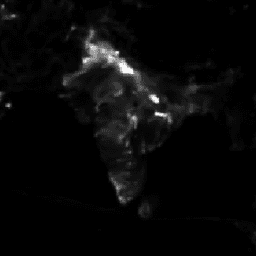
- Disponibilidad del conjunto de datos
- 2018-01-01T00:00:00Z–2025-12-08T12:00:00Z
- Proveedor del conjunto de datos
- NASA/GMAO
- Etiquetas
Descripción
Este conjunto de datos contiene la repetición meteorológica (rpl) de datos de alta frecuencia temporal (htf). La previsión de composición del Sistema Goddard de Observación de la Tierra (GEOS-CF) es un método global de predicción de componentes de alta resolución (0.25°) del Global Modeling and Assimilation Office (GMAO) de la NASA.
GEOS-CF ofrece una nueva herramienta para la investigación de las transformaciones químicas de la atmósfera, con el objetivo de complementar la amplia variedad de observaciones in situ y espaciales que realiza la NASA. GEOS-CF amplía el sistema de modelos de aerosoles y el clima de GEOS con la introducción del módulo de química GEOS-Chem para proporcionar retropronósticos y pronósticos de 5 días de los componentes atmosféricos, incluidos el ozono (O3), el monóxido de carbono (CO), el dióxido de nitrógeno (NO2), el dióxido de azufre (SO2) y el material particulado fino (PM2.5). El módulo de química integrado en GEOS-CF es idéntico al modelo sin conexión de GEOS-Chem y se beneficia fácilmente de las innovaciones que proporciona la comunidad de GEOS-Chem.
La evaluación de GEOS-CF en comparación con las observaciones satelitales, de ozonosondeo y de superficie para los años 2018 y 2019 demuestra concentraciones simuladas realistas de O3, NO2 y CO, con sesgos medios normalizados de −0.1 a 0.3, raíces cuadradas del error cuadrático medio normalizadas entre 0.1 y 0.4, y correlaciones entre 0.3 y 0.8. Las comparaciones con las observaciones de la superficie destacan la representación exitosa de los contaminantes del aire en muchas regiones del mundo y durante todas las estaciones, pero también resaltan las limitaciones actuales, como un sesgo alto a nivel mundial para el SO2 y una predicción excesiva del O3 de verano en el sudeste de Estados Unidos.
En general, GEOS-CF v1.0 sobreestima los aerosoles entre un 20% y un 50% debido a problemas conocidos en GEOS-Chem v12.0.1 que se abordaron en versiones posteriores. Las previsiones de 5 días tienen puntuaciones de habilidad comparables a las de la previsión retrospectiva de 1 día. Las habilidades del modelo se pueden mejorar significativamente si se aplica una corrección del sesgo al resultado del modelo superficial utilizando un enfoque de aprendizaje automático.
Bandas
Tamaño de los píxeles
27,750 metros
Bandas
| Nombre | Unidades | Tamaño de los píxeles | Descripción |
|---|---|---|---|
CO |
Fracción molar | metros | Proporción de mezcla de volumen de monóxido de carbono (CO, PM = 28.00 g mol⁻¹) en aire seco |
NO2 |
Fracción molar | metros | Proporción de mezcla de volumen de dióxido de nitrógeno (NO2, PM = 46.00 g mol-1) en aire seco |
O3 |
Fracción molar | metros | Proporción de mezcla de volumen de ozono (O3, PM = 48.00 g mol-1) en aire seco |
PM25_RH35_GCC |
µg/m³ | metros | Material particulado con un diámetro inferior a 2.5 µm, HR del 35% |
PM25_RH35_GOCART |
kg/m³ | metros | PM2.5 reconstruido total con HR del 35% |
Q |
Fracción de masa | metros | Humedad específica |
RH |
metros | Humedad relativa después del rocío |
|
SLP |
Pa | metros | Presión a nivel del mar |
SO2 |
Fracción molar | metros | Proporción de mezcla de volumen de dióxido de azufre (SO2, PM = 64.00 g mol-1) en aire seco |
T |
K | metros | Temperatura del aire |
U |
m/s | metros | Viento hacia el este |
V |
m/s | metros | Viento hacia el norte |
Condiciones de Uso
Condiciones de Uso
A menos que se indique lo contrario, todos los datos producidos por la NASA se pueden usar para cualquier propósito sin permiso previo. Para obtener más información y conocer las excepciones, visita la página de la Política de Datos e Información de la NASA.
Citas
Keller, C. A., Knowland, K. E., Duncan, B. N., Liu, J., Anderson, D. C., Das, S., … y Pawson, S. (2021). Description of the NASA GEOS composition forecast modeling system GEOS-CF v1. 0. Journal of Advances in Modeling Earth Systems, 13(4), e2020MS002413. doi:10.1029/2020MS002413
DOI
Explora con Earth Engine
Editor de código (JavaScript)
var imageVisParamNO2 = { 'bands': ['NO2'], 'min': 6.96e-11, 'max': 4.42e-8, }; var imageVisParamT = { 'bands': ['T'], 'min': 220, 'max': 320, 'palette': ['d7191c', 'fdae61', 'ffffbf', 'abd9e9', '2c7bb6'], }; var geosCf = ee.ImageCollection('NASA/GEOS-CF/v1/rpl/htf'); Map.setCenter(100, 20, 3); var weeklyT = geosCf.select('T').filterDate('2019-06-01', '2019-06-08').median(); Map.addLayer(weeklyT, imageVisParamT, 'Weekly T', false, 1); var NO2 = ee.Image('NASA/GEOS-CF/v1/rpl/htf/20190601_0000z'); Map.addLayer(NO2, imageVisParamNO2, 'NO2', true, 1);
